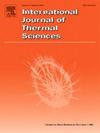Rotational flow and heat transfer in a serpentine cooling channel with realistic internal cooling schemes of a turbine blade
IF 4.9
2区 工程技术
Q1 ENGINEERING, MECHANICAL
International Journal of Thermal Sciences
Pub Date : 2025-03-17
DOI:10.1016/j.ijthermalsci.2025.109863
引用次数: 0
Abstract
Modern advanced turbine blade mid-chord cooling systems typically have three passages with different geometric shapes and cooling schemes. The current study conducts experimental and numerical analysis of the aerothermodynamic performance in a blade-shaped serpentine channel. The channel features asymmetric cross sections, 180-degree tip and hub turns, a minor secondary inlet, staggered ribs and bleed holes. The main inlet Reynolds number (Re) and rotation number (Ro) respectively vary between 17000 and 33000 and from 0 to 0.4, and the mass flow ratio of the minor secondary coolant to the main (MR) ranges from 0 to 0.2. It is revealed that the flow interactions between bleed holes and ribs significantly improve wall heat transfer. The rotation effect on heat transfer is less pronounced in a realistic channel than in a smooth one. The minor secondary stream can increase the channel heat transfer, and the ideal MR falls between 0.1 and 0.15. The proportion of the mass flow rate of each bleed hole to the total remains almost consistent regardless of the Re and Ro. Finally, the correlations of averaged heat transfer with high accuracy (≤10 %) are developed, which could interest turbine blade researchers and designers.
现代先进的涡轮叶片中弦冷却系统通常有三个不同几何形状和冷却方案的通道。本研究对叶片形蛇形通道的空气热力学性能进行了实验和数值分析。该通道具有不对称横截面、180 度的顶端和轮毂转角、一个小的次级入口、交错的肋条和排气孔。主入口雷诺数(Re)和旋转数(Ro)分别在 17000 至 33000 之间和 0 至 0.4 之间变化,次级冷却剂与主冷却剂的质量流量比(MR)在 0 至 0.2 之间。结果表明,放气孔和肋条之间的流动相互作用显著改善了壁面传热。与光滑通道相比,旋转对传热的影响在现实通道中并不明显。微小的二次流可以增加通道传热,理想的 MR 值在 0.1 至 0.15 之间。无论 Re 和 Ro 如何变化,每个排放孔的质量流量占总流量的比例几乎保持一致。最后,研究还得出了高精度(≤10%)的平均传热相关性,涡轮叶片研究人员和设计人员可能会对此感兴趣。
本文章由计算机程序翻译,如有差异,请以英文原文为准。
求助全文
约1分钟内获得全文
求助全文
来源期刊

International Journal of Thermal Sciences
工程技术-工程:机械
CiteScore
8.10
自引率
11.10%
发文量
531
审稿时长
55 days
期刊介绍:
The International Journal of Thermal Sciences is a journal devoted to the publication of fundamental studies on the physics of transfer processes in general, with an emphasis on thermal aspects and also applied research on various processes, energy systems and the environment. Articles are published in English and French, and are subject to peer review.
The fundamental subjects considered within the scope of the journal are:
* Heat and relevant mass transfer at all scales (nano, micro and macro) and in all types of material (heterogeneous, composites, biological,...) and fluid flow
* Forced, natural or mixed convection in reactive or non-reactive media
* Single or multi–phase fluid flow with or without phase change
* Near–and far–field radiative heat transfer
* Combined modes of heat transfer in complex systems (for example, plasmas, biological, geological,...)
* Multiscale modelling
The applied research topics include:
* Heat exchangers, heat pipes, cooling processes
* Transport phenomena taking place in industrial processes (chemical, food and agricultural, metallurgical, space and aeronautical, automobile industries)
* Nano–and micro–technology for energy, space, biosystems and devices
* Heat transport analysis in advanced systems
* Impact of energy–related processes on environment, and emerging energy systems
The study of thermophysical properties of materials and fluids, thermal measurement techniques, inverse methods, and the developments of experimental methods are within the scope of the International Journal of Thermal Sciences which also covers the modelling, and numerical methods applied to thermal transfer.
 求助内容:
求助内容: 应助结果提醒方式:
应助结果提醒方式:


